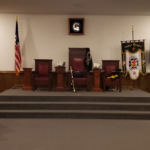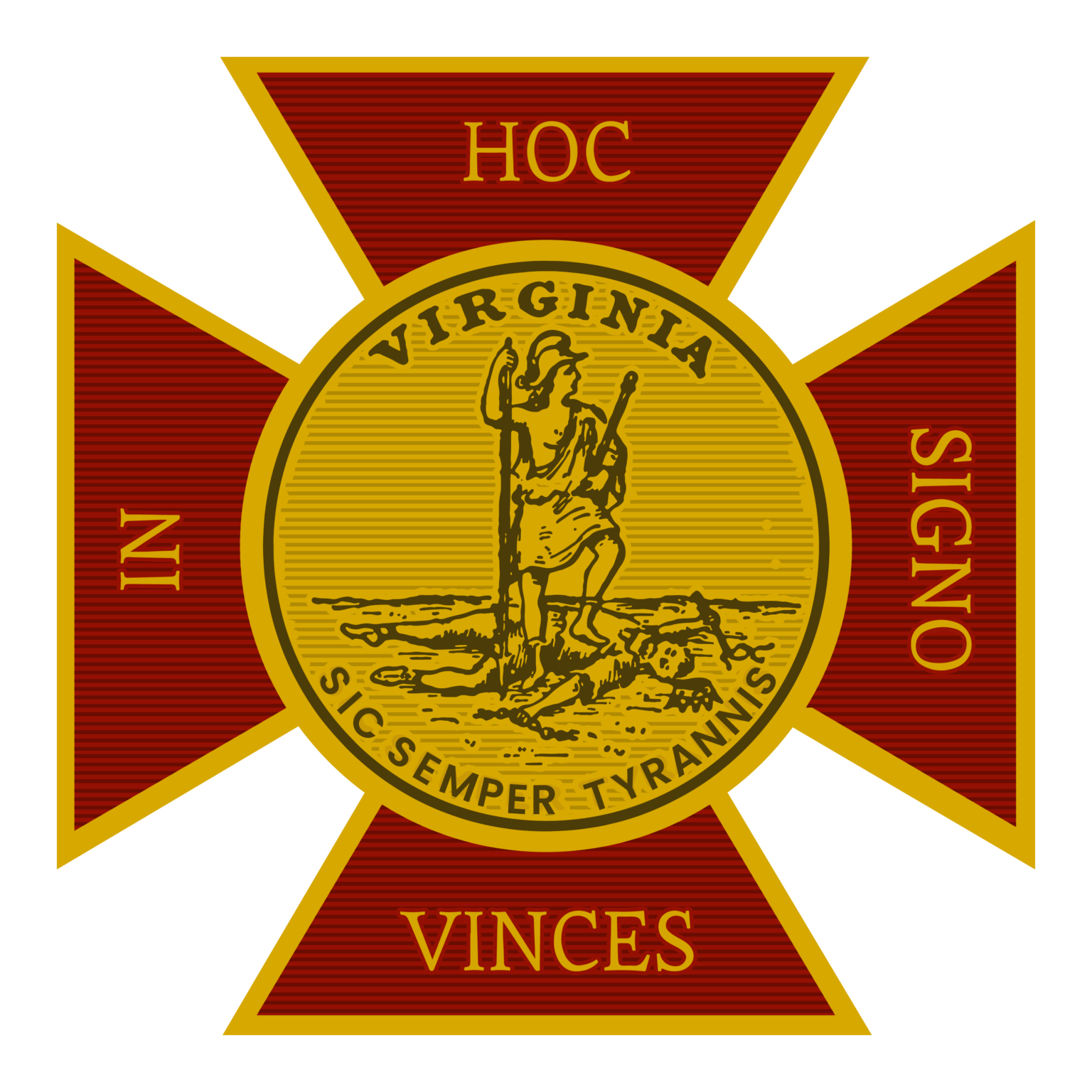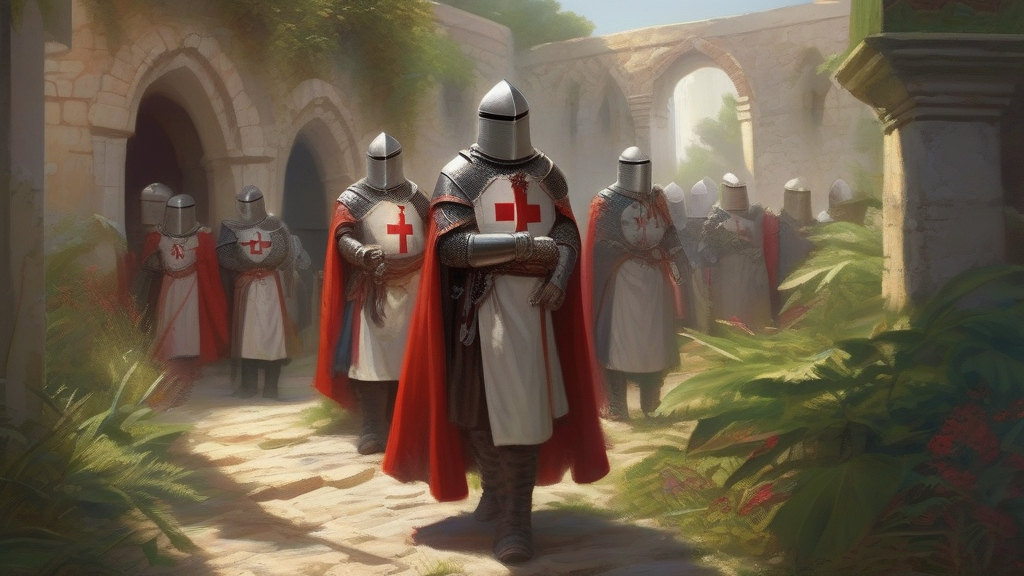Chartered January 27, 1827
On January 16th, 1827, three Sir Knights (James Cushman, Charles Cassell and Mark L. Cheevers), hailing from three different Commanderies, and acting under a lawful warrant (dispensation) from the Grand Encampment Knights Templar of Virginia did on that date conferred the Orders of Knighthood upon the following Royal Arch Masons from Mount Horeb Chapter No. 11:
Charles A. Grice | Robert B. Butt | Mordicai K. Cook | James Jarvis
George Reed | Henry Singleton | John Williston | William Bishop
J. W. Murdaugh | John Linn | John Reed | James B. Foster
All of whom, after useful, honorable, and well-spent lives, entered the asylum, where the Captain of Salvation forever reigns. Those twelve Sir Knights received a Grand Encampment of Virginia dispensation, dated January 16th, 1827, and proceeded to organize “Portsmouth Encampment, No. 5,” after which they elected Sir Knight Charles A. Grice its first Eminent Commander. The Grand Encampment of Knights Templar of Virginia chartered Portsmouth Encampment, No. 5 on January 27, 1827, at Portsmouth, Virginia.
Sir Knight Grice was re-elected annually thereafter until the year 1866, when by reason of this declining years, he declined a further re-election, and made the mantle of office fall upon the shoulders of Eminent Sir Charles R. McAlpine.
We cannot let the occasion pass without mentioning that Sir Knight Charles A. Grice occupied many exalted positions during his years in the Masonic Fraternity:
Raised in Portsmouth Naval Lodge No 100 in 1818, he served Worshipful Master, Portsmouth Naval Lodge 1820-1821, 1835, 1839, 1859-1860, and District Deputy Grand Master, District No. 1 (Portsmouth) 1864-1867.
Exalted in Portsmouth’s Mt. Horeb Chapter No. 11 and served as its High Priest for many years
Most Excellent Grand High Priest of the Grand Royal Arch Chapter of Virginia in 1841-1843
Instrumental in forming Portsmouth Commandery No. 5, Knights Templar January 6, 1827, and served as first Commander of Portsmouth Commandery from 1827 and served as Commander for thirty-eight years.
Most Eminent Grand Master of the Grand Encampment of Knights Templars of Virginia from 1830-1839 when he declined re-election and was succeeded by E. Sir John Pollard, of Petersburg, Virginia.
On the reorganization of the Grand Encampment of Virginia, December 11th, 1845, Sir Knight Sir Charles A. Grice, was elected Right Eminent Grand Commander of the Grand Commandery of Knights Templar of Virginia, and filled the office until December 13, 1849, when he was succeeded by Sir Knight Edward H. Gill of Richmond, Virginia.
On June 7, 1855, the Steamer Benjamin Franklin sailed into the Chesapeake Bay bound for repairs. Hampton Roads experienced Yellow Fever plague in 1795, 1802, 1821 and 1826, but the pestilence of 1855 claimed a third of the populations of Norfolk and Portsmouth. It took a heavy toll on the members of Portsmouth’s Masonic Family – the Fraternity’s many of most zealous Masons, skillful in the art of the Craft and active to a fault and left an additional eighteen widows and sixty-one orphans to care for: that in addition to fifteen widows and thirty-eight orphans from previous epidemics.
At 4:30 AM on April 12, 1861, Fort Sumter was fired upon, and Virginia became a prominent part of the Confederacy when it joined during the American Civil War on April 17, 1861. Portsmouth Commandery had thirty-three knights on its rolls at the start of the Civil War. Around noon March 8, 1862, the CSS Virginia sailed down the Elizabeth River from Gasport Shipyard; two months later on May 10, the Gasport Shipyard was burned, and Portsmouth evacuated Confederate forces to Suffolk. That was the beginning of eight years of Federal occupation of Portsmouth. There were no records for the years 1863 and 1864, but in 1865 there were fifty-seven knights on Portsmouth Commandery’s rolls.
Portsmouth Commandery’s second Commander, Sir Knight Charles R. McAlpiner was elected Eminent Commander in 1866 and served until March 18th, 1872, when he resigned and demitted from the Commandery. During his administration, the Commandery enjoyed an era of prosperity and success, and several notable events took place and in which this Commandery participated:
Membership in Portsmouth Commandery rose to fifty-seven in 1865 as Confederate Veterans returned to Hampton Roads. Then membership dropped to forty-six in 1866 with the charter of Grice Commandery No. 16 in Norfolk. And membership rose to fifty-six in 1872.
June 13, 1869, the Commandery, by invitation from St. John’s Commandery No. 4 of Pennsylvania, proceeded to Philadelphia and participated in the celebration of their Semi-Centennial Anniversary.
In March 1870, Portsmouth Commandery had a serious controversy with Grice Commandery No. 16 with Commanderies claiming jurisdiction over Old Point and Hampton. The matter was being laid before Right Eminent Grand Commander Sir John Robin McDaniel, who decided that the disputed territory was within the jurisdiction of No. 16. Not satisfied with this decision, Eminent Commander Sir Knight McAlpine appealed from the decision of the Grand Commander to the Grand Master of the Grand Encampment of the United States. Sir Knight McDaniel promptly suspended Portsmouth Commandery’s charter for insubordination, but Sir Knight McAlpine, having made the proper apology, the charter was promptly restored on June 20, 1870.
June 22, 1870, the honored and well-beloved Frater, Sir Knight Charles Augusta Grice, Right Eminent Past Grand Commander, at the age of seventy-eight, set aside his sword and his Craftsman’s tools. He was buried on June 22 with Masonic honors and ceremonies and interred in Portsmouth’s Cedar Grove Ceremony. The Knights of Portsmouth Commandery No. 5 and Grice Commandery No. 16 escorted the funeral and Masonic ceremonies.
Portsmouth Commandery celebrated its 44th Anniversary on January 16, 1871, with Grice Commandery No. 16 as its guest. The ceremony included a street parade, drill and inspection, an oration by Portsmouth Commandry’s Prelate Rev. Sir Knight J.S. Lindsay, and a splendid evening banquet was enjoyed by all.
On April 18, 1871, Portsmouth Commandery assisted Grice Commandery No. 16 in escorting the Symbolic Blue Lodges of Norfolk, Portsmouth, and other Hampton Roads at the ceremony of laying the corner-stone of the Masonic Temple of Norfolk.
Then on September 18, 1871, Portsmouth Commandery made a pilgrimage to Baltimore to attend the XVIII Triennial Conclave of the Grand Encampment of the United States.
On March 18, 1872, Portsmouth Commandery’s third Commander, Sir Knight James Gaskins Baine was elected Eminent Commander and was annually re-elected until June 24, 1875. The following noted events were participated in during his term of office:
June 12, 1873, at the Annual Conclave of the Grand Commandery of Virginia, held in the City of Norfolk, a competitive drill was held in which Richmond Commandery No. 2, Portsmouth Commandery No. 5, and Grice Commandery No. 16 were represented. Portsmouth Commandery, No. 5, having been judged to be the best drilled and equipped Commandery, was awarded the prize consisting of a beautiful Beauseant Banner. The award was publicly made at the new Opera House in Norfolk, in the presence of a large number of visiting Sir Knights and the public.
On May 29, 1875, Portsmouth Commandery made a pilgrimage to New York to participate in the dedication of the Masonic Temple as the guest of Ivanhoe Commandery No. 36.
During Grand Commandery of Virginia’s Period of Reconstruction and Maturity there was strong disconcertment among the Sir Knights to withdraw from the Grand Encampment, but there was little to attain the desired end. When two strong leaders of Templar Masonry, who also were proponents of strong bonds with the Grand Encampment, died, Most Eminent Edward H. Gill in 1869 and Most Eminent Charles A. Grice in 1870, the agitation rose again, and again the efforts were for naught. The influence of Sir Knights Grice and Gill that Templarism is different, it is a military and Christian institution, requiring a different organization, a central government, one general head, but representative in its charity, by which the sovereignty of each Grand Commandery is secured.
1875 to 1914 ushered in a period of peace, prosperity, and harmony throughout Hampton Roads and Portsmouth Commandery No. 5 was duly drilled, inspected, and encamped in solemn form. They were visible in full uniform escorting Portsmouth Naval and Seaboard Lodges at Cornerstone Ceremonies and mounted and unmounted escorts at Masonic Funerals. They marched in full uniform in various parades and at divine services in the many community churches in Portsmouth.
The rolls of Templary Masonry rose to 163 Sir Knights and the Hampton Commandery received a dispensation in 1887. Both Hampton Roads Commanderies, Portsmouth Commandery No. 5 and Grice Commandery No. 16, were at the chartering of Hampton Commandery No. 17 on July 17, 1888.
“Remember the Maine” became the rallying point during the Spanish-America War in 1898, followed the saber-rattling, war drums, and storm clouds heralding World War I (1914-1918) and Portsmouth Commandery No. 5 membership rolls rose to 185 Sir Knights. During the period Portsmouth Commandery was host to many Virginia and out-of-state Fraters but the Grim Reaper also scratched though the names of many Portsmouth Commandery’s valiant and magnanimous Knights. As the Versailles Treaty officially ended World War I on June 28, 1919, and by year’s end Portsmouth Commandery rolls boasted 241 Knights.
At the Grand Commandery Centennial Conclave and Ceremony on October 26 and 27, 1922, Portsmouth Commandery No. 5 had fifty-two Knights and thirty-five Ladies in attendance. During the Uniform Parade up Richmond’s Monument Avenue, Portsmouth Commandery No. 5, Grice Commandery No. 16, and Hampton Commandery No. 17 combined a Company of Sir Knights from Hampton Roads.
Returning to the Sir Knights of Portsmouth Commandery refocused to their Templary tactics and ritual and escorting Portsmouth Lodge Cornerstone Ceremonies for community churches and public buildings. They were visually presenting flag programs and wreath laying ceremonies, escorting Masonic funerals, marching in formation in parades, attending divine services, and pilgrimages to George Washington’s tomb at Mount Vernon. Portsmouth Commandery No. 5, along with Grice Commandery No. 16, Hampton Commandery No. 17, Malta Commandery No. 24, and Sir Knights from North and South Carolina participated in Virginia Encampment/Field Weeks in 1925 and 1926 near the Cape Henry Lighthouse. Portsmouth Commandery membership rolls grew to 333 Sir Knights and the Commandery made three pilgrimages to Grand Encampment Conclaves: XXXV Triennial held April 25-27, 1922, in New Orleans,
Louisiana; XXXVI Triennial held July 28-31, 1925, in Seattle, Washington; and XXXVII Triennial held July 16-19, 1928, in Detroit, Michigan.
The 1929 Stock Market Crash and the Great Depression culminated in many Virginian Masonic Lodges experienced large membership losses from demits and suspensions which affected Templar Masonry. Portsmouth Commandery was no exception as the Commandery lost ninety-one knights from demits, suspensions, and deaths from 1929 to the end of 1939.
On October 27, 1939, Sir Knight Richard S. Luckett, Right Eminent Grand Commander, attended the Annual Inspection Portsmouth Commandery No. 5 with Sir Knight A. M. Conner, Eminent District Deputy Grand Commander for District 2, as the Inspector and there sixty-five uniformed Sir Knights in the Inspection Line. The Ladies were invited to witness the Inspection Ceremonies which were public and afforded a delightful occasion. After the Inspection Ceremonies, a delicious dinner was served to 226 Sir Knights, Ladies, and Guests. Portsmouth Commandery Inspection Ceremonies were public in the 1940s according to the Ladies, a place of prominence in the Commandery’s Templar Activities.
The 1940s, 1950s, and 1960s were a period of transformation for Portsmouth Commandery No. 5. World War II was one the darkest periods in the history of the world and the all-out support for the war effort and the rise in patriotism was the profound conviction that Templar Masonry was needed. The war efforts were the spark Portsmouth Commandery needed. From 1940 to the end of 1969, the Commandry’s membership rolls grew from 1940 (242 knights) to the end of 1969 (423 knights) by 181 knights.
The 1970 through 2021 period was a fifty-one-year roller-coaster ride for Portsmouth Commandery No. 5 with changes overnight. There were annual membership losses. Then in 2010 Malta Commandery No. 24 and Island Commandery No. 34 merged under the name of Malta Commandery No. 24 at Chincoteague and Chesapeake Commandery No.28 merged with Malta Commandery No. 24 in 2014 and finally Malta Commandery No. 24 merged with Portsmouth Commandery No. 5 in 2017. Portsmouth Commandery grew from 108 knights in 2016 to 178 knights in 2017 and it has been dropping from deaths, demits, and suspensions.
Three Knight Templar Commanderies were chartered in the Virginia Eastern Shore: Malta Commandery No. 24 at Onancock in 1906, Chesapeake Commandery No. 27 at Northampton County in 1922, and Island Commandery No. 34 at Chincoteague in 1997. Then Malta Commandery No. 24 and Island Commandery No. 34 merged under the name of Malta Commandery No. 24 at Chincoteague in 2010. Finally, Chesapeake Commandery No.28 merged with Malta Commandery No. 24 in 2014 and Malta Commandery No. 24 merged with Portsmouth Commandery No. 5 at Portsmouth, Virginia in 2017.
Portsmouth Commandery No. 5 has a long and illustrious history. One of the services to the Portsmouth and Hampton Roads communities, the Masonic and Templar communities, and Grand Commandery of Virginia. Its membership rolls stretch from Portsmouth to Petersburg, Yorktown, Lexington, Troutville, Suffolk, Norfolk Chesapeake, Virginia Beach, the Eastern Shore, Carrsville, Franklin, Zuni, Windsor, Courtland and into the states of California, Florida, Georgia, Illinois, Louisiana, Maryland, North Carolina, New York, Ohio, Pennsylvania, South Carolina . Its knights are known for their ritual skills in Symbolic Lodges, Royal Arch Chapters, and Commanderies of Knight Templar. Their strengths are leadership, fellowship, Masonic knowledge, and willingness to travel, visit and support their fellow Brethren, Companions, and Knights Templar.
The Wooding Trophy was presented to the Grand Commandery by Sir Knight W. Crews Wooding, Right Eminent Grand Commander in 1929, to stimulate and encourage Commanderies to a greater zeal and to improve proficiency. This award continues to be made annually to the Commandery scoring the highest number of points based on the information contained in the District Deputy Grand Commander’s Annual Report for each Commandery. This is a rotating trophy awarded annually at the Grand Conclave to the Commandery scoring the highest number of points during the year just concluded. The Sir Knights of Portsmouth Commandery have always been highly active in local, regional, and state events and Portsmouth Commandery No. 5 has been awarded the Wooding Trophy 25 times since 1930 (three times more than any other Virginia Constituent Commandery):
1937 1946 1952 1984 2012
1940 1947 1976 1984 2013
1941 1949 1979 1991 2015
1942 1950 1980 2006 2017
1943 1951 1981 2011 2020
Distinguished Right Eminent Grand Commanders (13)
Sir Knight Charles Augusta Grice 1830-1839/1845-1849
Sir Knight Hanes Gaskins Bain 1878-1880
Sir Knight William Lee Davis 1916-1917
Sir Knight George Craighead Cabell 1919-1920
Sir Knight Carroll Myers 1950-1951
Sir Knight Silverius C. Chur 1968-1969
Sir Knight Ivan Clayton Myers 1972-1973
Sir Knight Clifton D, March 1976-1977
Sir Knight George Benge Yeates 1982-1983
Sir Knight Commodore Dewey Elliott, Jr. 1993-1994
Sir Knight Joseph Patrick Westfall, Jr. 2016-2017
Sir Knight Benjamin Franklin Hill 2019-2020
Sir Knight Peter Reginald Spring 2021-2022
Recipients of the Knight Templar Cross of Honor (6)
Sir Knight Bryan J. Shockley Sir Knight Carlton A. Drummond
Sir Knight Joseph P. Westfall, Jr. Sir Knight Bruce L. Van Buren
Sir Knight Benjamin F. Hill Sir Knight Frederick E. Lewis
Recipients of the Knight Commander of the Temple (13)
Sir Knight Commodore B. Elliott, Jr. Sir Knight E. Robinson Lee
Sir Knight Joseph P. Westfall, Jr. Sir Knight Clayton M. Robertson
Sir Knight Burleigh M. Tatum Sir Knight George B. Yeates
Sir Knight Fred L. Younger Sir Knight Joseph W. Jeffries
Sir Knight Carlton E. Kight Sir Knight Ira C. Hudson
Sir Knight William T. Hargrove Sir Knight Peter R. Spring
Sir Knight Major G. Stephenson III
Recipients of the Companion of the Temple (6)
Thomas F. May Carolann P. Hill
Christi D. Reed Cassandra H. McBride
Mary O. Murray Pamela G. Stephenson
Charles A. Grice Meritorious Award (8)
Sir Knight George B. Yeates Sir Knight E. Robinson Lee
Sir Knight Ira C. Hudson Sir Knight Joseph P. Westfall, Jr.
Sir Knight Bruce L. Van Buren Sir Knight Randall R. Reed
Sir Knight Joseph R. Murray, Sr. Sir Knight Wayne H. Anderson
Grand Commandery Meritorious Service Medal (3)
Sir Knight John R. Goodwin Sir Knight Joel T. Bundy, MD
Sir Knight Robert G. McBride
History Contributions By:
Sir Knight Benjamin Franklin Hill, KTCH/REPGC






